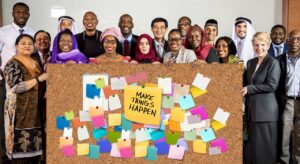Why Learning Should Be An Organizational Culture

Written by: Rashmi Anchi
Organizations are in a mode of transformation where they are orienting employees about the importance of constant learning. Also, they are integrating recruitment and selection strategies where they bring in employees who have the attitude and keenness to keep learning while they work and accomplish organizational goals with effective transfer of what has been learnt.
Let’s take an instance where the Talent Acquisition Officer is in the process of identifying a potential candidate for a job that needs learning in the crucial areas of work. What will the Officer look at while hiring to ensure he is getting the right person in? The very first thing a candidate offers to an organization is his CV. The CV describes the dimensions of the person right from academics, curriculars, interests and achievements. The CV acts as a blueprint of how a person will grow within the organization and what areas will that person potentially contribute to gain organizational success. Attributes such as regular reading, habitual writing, active listening and high interaction and communication skills can help you bag a decent job in a renowned organization because most of them follow a learning culture.
Related – Talent Diversity – Creating Organizations With Global Culture
A learning culture is one wherein learning is encouraged at every step each employee takes. According to American Systems Scientist, Peter Senge; it promotes both, adaptive and generative learning. Adaptive learning refers to the learning that addresses every individual’s unique needs and based on that provides real-time feedback, creates guidelines to carry on further work and ascertains resources needed to move ahead, whereas generative learning is the involvement of people’s active integration of the new thoughts and ideas that keep coming to them. Thinking outside the box is a resourceful element when it comes to imbibing a learning culture, coming up with anything new matters! In small organizations and where there is potential scope for growth and development, every person is given an equal opportunity to bring something new to the table. A discussion takes place, ideas are looked at from various perspectives, pros and cons are put up and then ideas are translated into possible products/services for the organization.
A learning culture has to be acquired with knowledge, opportunities and skills of human resources. Team learning is another major aspect of such a culture where there is continuous reinforcement and reinvention of thoughts, ideas and all that is put forth to be shared. The main purpose behind this practice is to develop a growth mindset.
What Is A Growth Mindset?
A collective thought process that thrives on challenges and that sees mistakes as stepping stones to success, leading to strengthening of abilities and in-built talents which are susceptible to growth.
A learning organization works on building a shared vision, systems thinking, mental models, team learning and personal mastery; this is what learned when I went through articles and most of them, all had these same points in common but there is so much more to it. Let’s dig a little deeper and try to visualize how will it be to be a part of an organization that adopts the learning culture!
Learning culture includes innovation, knowledge sharing, problem-solving, creates a sense of communication, brings out efficiency, experimenting and ensures effective transfer and application in the work.
How To Bring This Change?
The change is a gradual process and can be brought into slowly and steadily. Not a lot of newness can be brought in once, but creating change in small chunks makes the process fun. All anticipate changes; hence no one is too overwhelmed when a concept or framework is introduced to them and simultaneously, the habit of continuous interactive learning is imbibed in all.
These changes have a long-term modification in the complete knowledge systems that companies have. The key to knowledge being retained is within shared values. Every organization has a set of core values or code of conduct that they diligently follow and that is the foundation for the employees to make strong connections. These connections boost the knowledge-sharing process.
According to me, a learning organizational culture must have the following:
1. Use All Brains:
Every person contributing to the organization in whatever capacity must be given a fair chance to speak up about what is in their mind. There are so many things that are needed to be known and we never know what can end up helping our functioning and operations. Agility and flexibility are very important to be able to understand and then share the others who don’t get what’s happening. This facilitates fostering networks and empowering the employees.
2. Collaborations Inside:
When new processes and tools are implemented into the workspace, there is a self-understanding role-undertaking of the employees. Some become teachers and some, learners. The continuous teaching and learning attitude comes to all as a reflex! Everybody wants to ensure that what one knows, must be known to all. Collaborations can be nurtured with the group online training; where colleagues are trained along with each other to build strong ties and instill the quality of group learn. This in turn leads to substantial exposure to new work content as well as peer-to-peer sharing.
3.The 3-Step Mantra:
Futurist Alvin Toffler developed a theory of education that specifies; that the process of learning never stops and has three stages: LEARN-UNLEARN-RELEARN. An article published on Forbes’ blog talks about this where the writer says technology brings comfort over time but you have got to unlearn the old and keep learning the new. Many experiences can turn around your beliefs that in today’s world everyone needs to have a learner’s mindset. This translates to happily embracing the natural discomfort that comes from letting go of the old things learnt and learning to master the new ones!
4. Learning Curve:
We all know what this is, a curve that illustrates the time that will be needed to acquire new skills and how these new skills can bring cost reduction to the company. Most of the employees are T-shaped individuals whose qualities make them add value, they have excellent domain know-how and refined skills in specific areas, which makes their work very niche and rare. Hence, it has been said, “An adaptable company will have adaptable people.”
5. Good Energy and Renewal:
One of the best things about learning culture in organizations is the power it presents. It supports learning, enhances the continuum of knowledge, helps reach specific goals, it restores both personal goals and professional growth, creates a safe and secure environment to share, includes creative tension and makes everyone aware through their constant interactions. It encourages reflection of knowledge and sharing it ahead with a new set of people within the same.
6. Contextual Intelligence:
The concept of contextual intelligence was developed years ago, but now is when we can relate it to the needs of the dynamic business environment. Earlier, employees would learn how their work was done and that was all that was needed to get the work done, effectively and efficiently. Owing to all the environmental changes we see nowadays; employees have to accept their level of knowledge and work on filling the gap between where they are and where they want to be and how it can be done. The environment keeps changing because the context of all jobs and the level of intelligence needed for each job are drastically evolving. Communication is the key! Lifelong learning makes space for innovation, builds leaders and puts forth forward thoughts.
I would like to end my take on the learning culture by saying that always keep learning, adapting and changing for the better good. It cultivates open-honest feedback for performance appraisals, attraction and retention of top talent. People become fast learners and many loopholes are addressed collectively. There is organizational growth and self-development which allows them to learn from mistakes and keep following their practices with one common vision in mind!
Jack Welch









